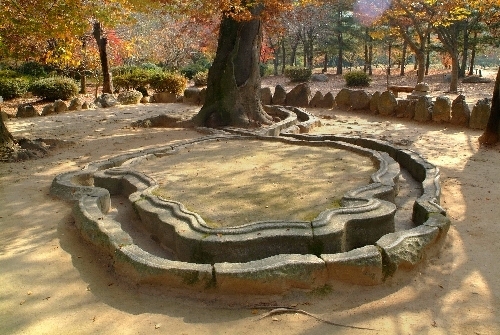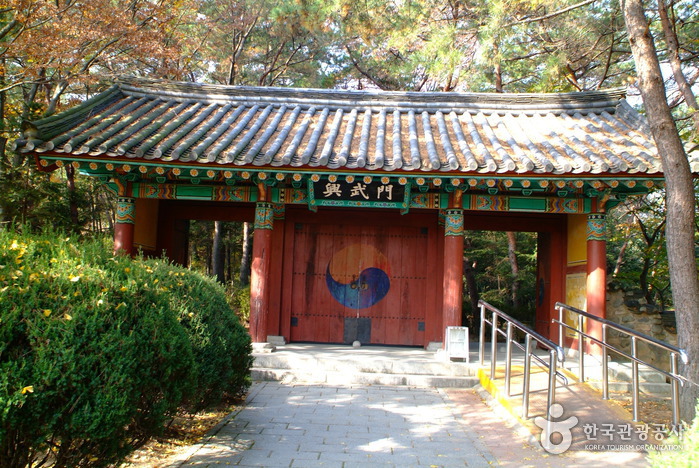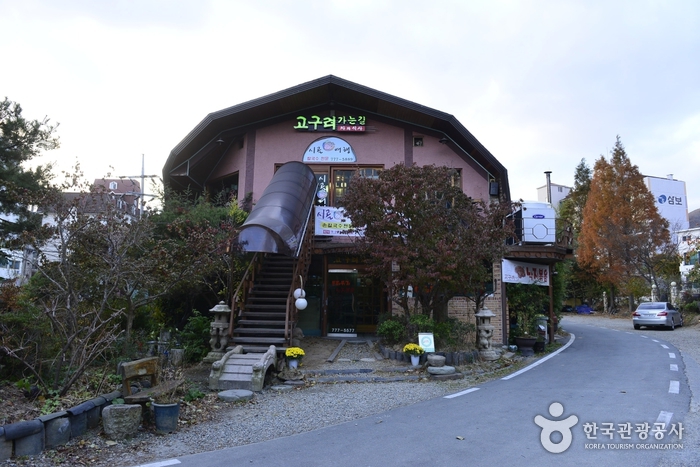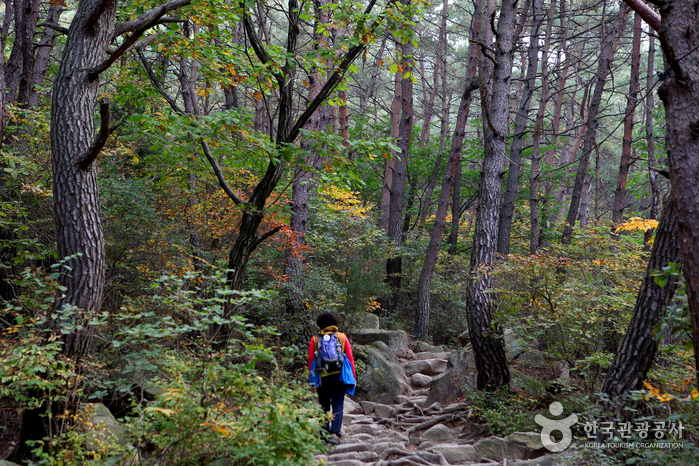Solar del Pabellón Poseokjeong (포석정지)
7.5Km 2020-10-12
Namsansunhwan-ro 816, Gyeongju-si, Gyeongsangbuk-do
+82-54-745-8484
Se levanta sobre una roca cerca de un arroyo, y Poseokjeong (superficie de 7.432 ㎡) fue designado monumento privado nº 1 el 21 de enero de 1963. La ubicación es la que había tenido el palacio de la villa real de la dinastía Silla (57 a.C.-935), pero las edificaciones ya no existen más y solo queda en el lugar un trayecto de agua con una roca de forma de concha. Poseokjeong fue denominado de esta forma porque las canaletas de la roca se semejaban a las rugosas conchas de abulón. Poseokjeong está construido con 63 rocas. Tiene un ancho de 35 cm, y una profundidad media de 26 cm, y la longitud total alcanza los 10 metros. Se dice que el agua del curso del valle de Namsan fue traída hasta aquí haciendo que saliese a borbotones a través de una piedra tortuga. Pero la tortuga ya ha desaparecido. Se dice que los reyes de Silla iban al lugar acompañados de sus oficiales y nobles, y que hacían flotar sus copas de vino sobre el borbotón del agua que fluía por la canaleta de piedra y antes de que su copa flotante llegara ante sí, debía recitar un poema. Junto con Poseokjeong, el Valle de Poseok era muy querido por la gente de los días de Silla por sus limpias aguas y hermosos paisajes. Por todo ello, el palacio de la villa real durante el reino de Silla fue construido aquí. Hoy en día, los árboles de zelcova, pino y bambú preservan el aire acogedor y relajante del lugar.
Templo Bulguksa en Gyeongju (경주 불국사) [Patrimonio Cultural de la Humanidad de la Unesco]
7.8Km 2025-03-17
Bulguk-ro 385, Gyeongju-si, Gyeongsangbuk-do
El templo Bulguksa es la reliquia representativa de Gyeongju y fue designado Patrimonio Cultural de la Humanidad por la Unesco en 1995. La belleza del templo en sí y el toque artístico de las reliquias de piedra son bien conocidos en el mundo entero.
El templo Bulguksa se construyó en 528 de nuestra era, durante la dinastía Silla, en el 15to. año del rey Beopeung (gobernó de 514 a 540). Entonces, llamaron al templo Hwaeom Bulguksa o Beomnyusa. En el año 751, bajo el gobierno de Gyeongdeok (de 742 a 765), Kim Dae-Seong (700-774) comenzó a reconstruirlo y finalizó la obra en el año 774, bajo el reinado del rey Hyegong (de 765 a 780). Después de largos 17 años de construcción, finalmente se le dio el nombre de Bulguksa. El nombre se mantuvo a través de las muchas obras de renovación del templo durante la dinastía Goryeo (918-1392) y la dinastía Joseon (1392-1910). Pero durante la Guerra de Imjin (guerra causada por la invasión japonesa al territorio coreano, 1592-1598) las edificaciones de madera fueron incendiadas, 819 años después de su primer establecimiento. Su reconstrucción fue iniciada desde 1604, durante la dinastía Joseon (año 37mo. del rey Seonjo) y hasta el año 1805 se renovó aproximadamente 40 veces, llegando al reinado de Sunjo (1790-1834). Aún después de aquellos días, el templo sufrió muchos robos y daños. En 1969, se formó el Comité de Restauración del Templo Bulguksa y Museoljeon, Gwaneumjeon, Birojeon, Gyeongnu y Hoerang, que habían sido dejados meramente como terrenos de las edificaciones originales, fueron reconstruidos en 1973. Otros lugares casi destruidos como Daeungjeon, Geungnakjeon, Beomyeongnu y Jahamun fueron reparados.
El templo Bulguksa de la actualidad tiene numerosas reliquias culturales preservadas en él, tales como la pagoda Dabotap (Tesoro Nacional), Seokgatap (Tesoro Nacional), Yeonhwagyo y Chilbogyo (Tesoro Nacional), Cheongungyo y Baekungyo (Tesoro Nacional), el Grabado en Oro del Buda Vairocana Sentado (Tesoro Nacional), la Figura de Oro del Amita Sentado (Tesoro Nacional) y la Saritap (Tesoro Nacional), entre otros.
Nombrados Tesoros Nacionales en 1962, Dabotap y Seokgatap son las pagodas de piedra representativas de Corea. Con una altura de 10,4 metros, se elevan al este y al oeste respectivamente entre el salón Daeungjeon y la puerta Jahamun. Seokgatap tiene tres alturas, arquetipo de la pagoda de piedra coreana. Dabotap es una pagoda octogonal construida sobre un estilóbato en forma de cruz con escaleras de piedra en los cuatro extremos y rodeada de balaustradas cuadradas. Esta construcción se edificó con tanta habilidad que resulta difícil imaginarla de piedra. Comparada con Seokgatap, se encuentra en un estado de conservación casi perfecto. Al este del salón Daeungjeon del templo se encuentran los puentes Cheongungyo y Baekungyo, y al oeste los puentes Yeonhwagyo y Chilbogyo. Unidos a la puerta Jahamun que conduce hasta Daeungjeon, los puentes Baekungyo y Cheongungyo simbolizan la unión entre el mundo humano, bajo los puentes, y el mundo de Buda, sobre ellos. Estos puentes poseen 33 peldaños en total; Cheongungyo con 17 peldaños se sitúa abajo, y Baekungyo con 16, arriba. Representan respectivamente la juventud y la vejez y simbolizan la vida. Son únicos en su estructura, ya que transforman un conjunto de peldaños en puente. En efecto, son los únicos puentes en perfecto estado de los construidos durante el reino de Silla y han sido nombrados Tesoros Nacionales. Al oeste, Yeonhwagyo y Chilbogyo son los puentes que unen la puerta de Anyangmun que conduce al edificio Geukrakjeon. Sobre los peldaños se han grabado motivos de pétalos de flores de loto, pero muchos se han difuminado con el paso del tiempo. Actualmente, está prohibido el acceso a este puente. Yeonhwago, junto con los puentes Cheongungyo y Baekungyo, ha sido nombrado «tesoro nacional» y está considerado como uno de los monumentos principales del templo Bulguksa.
Desde los puentes Cheongungyo y Baekungyo, se puede divisar el pabellón Beomyeongru a la izquierda. Edificado en 751 y destruido más tarde por el ejército nipón en 1593 durante las invasiones japonesas, fue restaurado dos veces durante la dinastía Joseon. El pabellón mantiene su forma actual desde los trabajos de restauración de 1973. Su dimensión se ha visto reducida con respecto a la original. Tiene una base grande, una parte mediana estrecha con columnas y un techo amplio. Las columnas son únicas, con ocho piedras diferentes y unidas en las cuatro direcciones cardinales.
Tumba del General Kim Yushin (경주 김유신묘)
8.0Km 2024-12-05
Chunghyo 2-gil 44-7, Gyeongju-si, Gyeongsangbuk-do.
La tumba del general Kim Yushin (595-673) está designado como Sitio Histórico. Se localiza en una escénica área llena de pinos en la colina este del monte Songha. Conocido como el héroe de la dinastía Silla, el general Kim Yushin fue el biznieto del rey Guhae, el último rey de la dinastía Gaya Geumgwan, y el hijo de Seo Hyeon, el gran general de la dinastía Silla. Yushin se alisto a los Hwarang (cuerpo de militares jóvenes aristócratas) a los 15 y empezó a soñar maneras para unificar la península de los Tres Reinos. Kim Yushin ganó su apoyo político mediante el establecimiento de una sólida relación con el noble Kim Chunchu y se hizo un nombre por sí mismo a través de su valor en el campo de batalla.
Cuando Kim Chunchu ascendió al trono como el 29º rey de la dinastía Silla (cambiando su nombre por rey Muyeol), Kim Yushin emergió de las filas y fue ascendido finalmente a la posición de Sangdaedeung (en el año 660, séptimo año del rey Muyeol). Kim Yushin, luego pasó a la derrota de Baekje en cooperación con la dinastía Tang, también más adelante la conquista de Goguryeo (año 668). La dinastía Tang, se volvió en contra de Silla tras la caída de Goguryeo, pero fue derrotado por el ejército de Kim Yushin junto con la armada de Goguryeo y Baekje. Con la caída de Tang, Kim Yushin finalmente realizó su sueño y unificó los tres reinos y fue nombrado al más alto puesto del gobierno de Silla en honor de su hazaña heroica.
La tumba del general Kim Yushin es una larga tumba que mide unos 30 metros de diámetro. Los relieves de los 12 dioses del zodiaco orientales (mitad hombre, mitad animal) hacen de guardianes alrededor de la tumba, blandiendo de armas. La tumba es la segunda en grandeza. Lo más importante de Yushin fue la contribución a la unificación de los Tres Reinos.
El camino hacia la tumba es un recorrido que no se puede escapar. Este camino tiene el nombre de Heungmuro, y ha sido seleccionado como uno de los 100 caminos más atractivos de Corea. El camino está lleno de cerezos en primavera y es famoso por ser un gran lugar para pasear o pasar en coche.
Goguryeoganeungil (고구려가는길 (낙지랑 쭈꾸미랑))
8.1Km 2017-01-12
66-6, Chunghyocheon-gil, Gyeongju-si, Gyeongsangbuk-do
+82-54-777-3389, +82-54-777-5589
This restaurant boasts the typical rustic look of a hwangto building, exemplifying the beauties of the past with traditional folk dishes. At night, customers can hear the soft melodies of live music.
GyeongjuCheonnyeonhanok Pension [Korea Quality] / 경주천년한옥펜션 [한국관광 품질인증]
8.1Km 2020-09-09
86-61, Sidong-ro, Gyeongju-si, Gyeongsangbuk-do
+82-10-9898-3995
Cheonnyeon Hanok Pension, located in Sirae-dong, Gyeongju-si, Gyeongsangbuk-do, was newly opened in April 2014. The owner discovered this geomantically ideal site, with a mountain to its rear and a river to its front, and constructed a 238m2 hanok on a 1,778m2 plot of land. The hanok is a ‘ㄱ’-shaped structure consisting of two floors above ground, with the guest accommodation situated on the first floor. The pension was named ‘Cheonnyeon Hanok’ to represent the owner’s wish that the house be preserved for over a thousand years (“cheon nyeon”). It is set amid a beautiful landscape and commands an open view of the nearby pine grove, a large pond, fields, and Tohamsan Mountain. The house is built of pine wood and red clay, and features an eco-friendly geothermal floor heating system and double-layered doors to keep out drafts. Although the outer yard is covered with gravel, the spacious grassy inner courtyard of the bonchae building is equipped with benches, and serves as both a playground for children and a relaxing space for adult guests. The garden is notable for its well-tended flowers and trees. The pension has 6 guestrooms including four single rooms (23m2); one room (29m2) with a numaru (upper floor) that can accommodate 3 to 5 people; and a two-room (46m2) suite that can accommodate 4 to 10 people. Maehwa-bang (single room) is characterized by rafters and a ‘井’-framed ceiling; Mogryeon-bang (two rooms) is a large guestroom that can accommodate two to three families, and has a sliding door in the middle for convenient use of the space; and Yeonggot-bang has an upper floor equipped with a BBQ facility. Large family groups tend to rent the Yeonggot-bang and an additional room. Other guests can also use the separate BBQ site in the courtyard. (Grill and charcoal: KRW 15,000 per 4 persons) Each room has a pleasant, clean interior and is equipped with a TV, fridge, air-conditioner, bathroom, sink, electric rice cooker, kettle, induction plaque, and Internet. The pension boasts a beautiful nighttime view of Joyang Reservoir, Tohamsan Mountain, and a pavilion of Bulguksa Temple. Guests can enjoy fishing in the reservoir and walking up the low mountain or strolling along the path through the pine grove. The pension also offers various folk games including Tuho (Arrow-throwing), Jegichagi (Korean shuttlecock game), Yunnori (traditional Korean board game) and kite-flying free of charge. In addition, it is close to a number of Gyeongju’s major tourist attractions including Seokguram Grotto and Bulguksa Temple, and is only 20 minutes’ drive from Gampo, Jusangjeolli Cliff, and the Royal Tomb of King Muyeol. Cheonnyeon Hanok Pension is particularly popular among families and groups.
Bulguksa Hanok Dongodang (불국사한옥동오당)
8.2Km 2024-07-30
5-58 Jinti-gil, Gyeongju-si, Gyeongsangbuk-do
Monte Namsan de Gyeongju (경주 남산)
8.3Km 2021-05-14
Namsan-dong, Gyeongju-si, Gyeongsangbuk-do.
+82-54-771-7142
El monte Namsan de Gyeongju está situado al sur de esta ciudad, que en la antigüedad era un sitio religioso y de suma importancia para la población del reino de Silla. Los picos más altos son el pico Geumobong (468 m) y el pico Gouibong (494 m), de los cuales brotan las aguas que recorren aproximadamente 40 valles y distintas cordilleras que forman la montaña. Observada desde arriba, presenta una forma ovalada y su extensión más al sur hace que la montaña se vea como un triángulo rectángulo.
La ladera de la parte oeste de la montaña es el lugar que dio paso a la leyenda de Bak Hyeokgeosae, el primer rey de Silla; y el patio Poseokjeong es el sitio trágico donde empezó la caída de la milenaria ciudad. Al este de la montaña, se encuentran distintas estatuas de Buda como Borisa Seokbuljwasang, la roca Bulmusa de Buda, etc; y al sur hay 12 tesoros nacionales como Chilbulam Maeseokbul, 12 sitios históricos como el patio Poseokjeong, Najeong, 9 patrimonios culturales locales y 1 importante legado histórico.
No solo sus ruinas y patrimonios sorprenden a los visitantes, sino también los senderos variados y los hermosos paisajes creados por diferentes valles y rocas, que son otro de los encantos que presenta la montaña. Muchos turistas elogian este tesoro diciendo “Para conocer Gyeongju, hay que subir primero el monte Namsan”. Por ello, este monte es considerado como el punto de origen del antiguo reino de Silla, que permitió unir la naturaleza y las creencias religiosas para crear una cultura milenaria única.
Gruta Seokguram de Gyeongju (경주 석굴암) [Patrimonio Cultural de la Humanidad de la Unesco]
8.3Km 2025-03-17
Seokgul-ro 238, Gyeongju-si, Gyeongsangbuk-do.
Seokguram, situado en el monte Tohamsan, es el templo de piedra representativo de Corea. El nombre oficial de Seokguram, un Tesoro Nacional, es Seokguram Seokgul. Designado como Emplazamiento de Patrimonio Cultural Mundial por la Unesco en 1995, es un templo artificial de piedra hecho de granito. La construcción comenzó con Kim Dae-seong (700-774) en el año 751, durante el reinado del rey Gyeong-deok (742-765) de la dinastía Silla (57 a.C.-935 d.C.) y se terminó veinticuatro años más tarde, en 774, durante el reinado del rey Hye-gong (765-780).
Seokguram es famoso por haber sido construido con el templo Bulguksa. Según el libro de historia Samgukyusa, de la dinastía Goryeo (el pueblo que unificó la Península Coreana a finales del período de Silla, 918-1392), Kim Dae-seong había construido Bulguksa para sus padres que estaban vivos, y Seokguram para los padres de su vida pasada.
Seokguram está hecho de granito, y está situado en el pico oriental del monte Tohamsan. Dentro de la sala principal, de forma redonda, están las estatuas de Bonjon Bodhisattva y sus discípulos. Seokguram se construyó para preservar estas estatuas. La figura de Bonjon, que luce una generosa sonrisa, está sentada en una plataforma esculpida con un diseño de flores de loto. El techo redondeado parece una media luna o un arco y sobre él tiene una cubierta decorada con flores de loto. Puesto que la salida del sol desde este lugar es muy hermosa, mucha gente sube a la montaña al amanecer.
Huewon [Korea Quality] / 휴원 [한국관광 품질인증]
8.4Km 2019-12-05
154, Chunghyoseoak-gil, Gyeongju-si, Gyeongsangbuk-do
+82-10-5651-1253
Huewon (休垣)
Huewon is a cozy hanok guesthouse located in Seoak-dong, Gyeongju. Since Gyeongju had been the capital of the Silla Dynasty for about a thousand years, Huewon is surrounded by various cultural heritage sites such as Tomb of King Muyeol, Tomb of King Jinji, and Seoakseowon Confucian Academy with a serene atmosphere.
Built in the 1970s and renovated later, Huewon started its accommodations service around 2011. Entering the gate, one can see a square-shaped courtyard giving a very bright and warm impression, in the middle of which is an old beautiful magnolia tree that is popular among visitors.
The garden is well-arranged with flower trees and bonsai trees and decorated with vintage items such as an old well and a water pump. Behind the house, the surroundings along with the low-altitude Seondosan Mountain make for beautiful seasonal scenery.
This cozy and pleasant hanok house has been well-maintained with the will and care of the owner, preserving the traditional hanok features including columns, beams, and rafters of the ceiling that show traces of time past.
The guestrooms are bright and clean with a delicate fragrance. Aside from red clay walls and clean beddings, however, there are no other additional facilities such as BBQ set because the guesthouse seeks to offer guests a quiet, healthy, and stable environment.
The guesthouse’s host, who has lived in Gyeongju for about 30 years and has engaged in promoting Gyeongju’s cultural heritages, willingly recommends to guests special travel destinations in Gyeongju and tells stories about Gyeongju.
In particular, the way to Dobongseodang Village School located behind Huewon is highly recommended by the host. Going up to the village school early morning, one is treated to a fantastic open view of Gyeongju in the fog. Moreover, Namsan Mountain, nicknamed Outdoor Museum since it is full of various Buddhist statues and towers here and there, is another recommended destination near the guesthouse.
Tumbas Samneung de Bae-dong en Gyeongju (경주 배동 삼릉)
8.5Km 2021-06-10
Bae-dong 73-1, Gyeongju-si, Gyeongsangbuk-do
+82-54-779-6100
Samneung significa "tres tumbas reales", y en este caso hace referencia a la de tres reyes del reino de Silla: Adala (8º de la dinastía), Sindeok (53º rey) y Gyeongmyeong (54º).

![Templo Bulguksa en Gyeongju (경주 불국사) [Patrimonio Cultural de la Humanidad de la Unesco]](http://tong.visitkorea.or.kr/cms/resource/03/2678603_image2_1.jpg)


![GyeongjuCheonnyeonhanok Pension [Korea Quality] / 경주천년한옥펜션 [한국관광 품질인증]](http://tong.visitkorea.or.kr/cms/resource/35/2635535_image2_1.jpg)


![Huewon [Korea Quality] / 휴원 [한국관광 품질인증]](http://tong.visitkorea.or.kr/cms/resource/45/2636545_image2_1.jpg)
 Español
Español
 한국어
한국어 English
English 日本語
日本語 中文(简体)
中文(简体) Deutsch
Deutsch Français
Français Русский
Русский